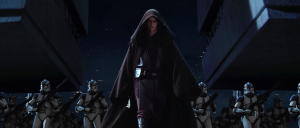An Analysis of Power and Authority in the Star Wars Universe
In her article What Is Authority, Hannah Arendt analyzes the meaning of authority and how authority is different from power. In addition, Arendt studies the sources of authority, and how authority can lead to totalitarianism or tyranny. Star Wars deals with many of the same questions, and often leaves them unanswered to allow us as viewers to contemplate the films. These questions are very important in the prequel trilogy, particularly Episode II: Attack of the Clones and Episode III: Revenge of the Sith. Star Wars asserts that the Galactic Senate has power and that the Jedi have power. Along with this, the films also imply that Palpatine is not tyrannical, but authoritarian.
In Star Wars, two main political groups exist within the Republic: the Galactic Senate and the Jedi Council. The Galactic Senate is made up of political figures who reside in the Republic’s domain, while the Jedi Council is made up of the elite Jedi masters. The Jedi, a group of force-wielding do-gooders, are known for their passiveness and purity. They abhor violence and any personal relationships besides those between Master and Padawan. The Jedi hold power over the Senate. They have the ability to rule over everyone in the Galaxy because they have the ability to wield the Force and have extremely high combat skills, whereas all the senators have is money and POLITICAL “power.” The Senate, however, holds authority over the Jedi. The Senate’s authority stems from its legislative and governmental powers. In the main canon, the Senate has the power to create laws, declare war, recognize Free Trade Zones, and have the ability to pressure the Jedi into carrying out their directives, even though the Jedi Council doesn’t necessarily answer directly to them. The Senate takes advantage of the Jedi’s passiveness and holds control over them, as the Jedi Council does the senate’s bidding. In the end, the Senate’s authority is what resulted in the destruction of the Republic itself. In a way, the fall of the Republic mirrors the fall of Ancient Rome. This comparison to Ancient Rome is extremely important because the Roman Empire was similar in cultural scope as was the Galactic Republic was in the context of their respective universe. In Rome, there was a senate made up of elected officials, and then ten “Tribunes of the People,” who were known for being pure and looking out for the greater good instead of their own personal good. Eventually, the senate grew more and more powerful, and the idea of having a top position became extremely appealing. Men would work towards becoming an emperor, and the Tribunes began to suffer at the hand of the emperor.
Another way that Star Wars follows ancient history is the tale of the Trojan horse. The Trojan horse was a large wooden horse used by the Greeks to sneakily invade Troy. In a way, Anakin Skywalker was the Jedi’s Trojan horse. After becoming increasingly powerful and gaining a good relationship with Senator Palpatine, the Jedi sent him in to spy on Palpatine to provide the Jedi with knowledge on his doings. They wanted to understand why the Chancellor was taking specific actions, as they had become suspicious that he had been corrupted somehow. That tactic ended up backfiring, as Anakin became Palpatine’s Trojan horse. Palpatine convinced Anakin that joining the Dark side of the force would provide him with great powers, including saving his dying wife. Cloaked in a Jedi robe, Anakin stormed the Jedi temple with a Clone army, killing all of the Jedi Padawans and ending the Jedi Order for the time being with the carrying out of Order 66.

Anakin, the Force-Wielding double Trojan Horse.
One important idea Arendt argues in What Is Authority is the concept of totalitarianism and tyranny. According to Arendt, “the difference between tyranny and authoritarian government has been that the tyrant rules in accordance with his own will and interest, whereas even the most draconic authoritarian government is bound by laws” (Arendt 97). Palpatine, oddly, has characteristics of both tyrants and authoritarians. Palpatine is acting in his own interests, which is a characteristic of a tyrant. However, Palpatine also cleverly manipulates the law in order to advance his power. For example, in The Phantom Menace, Palpatine calls for a “vote of no confidence” for the current chancellor, which is the Star Wars equivalent to an impeachment. Another example is when Palpatine has Jar-Jar act as a substitute for Senator Amidala in Attack of the Clones. There is one main thing that makes Palpatine more of an authoritarian than a tyrant: his source of authority. According to Arendt, “the source of authority in an authoritarian government is always a force external and superior to its own power.” Palpatine’s external source of power happens to be his force wielding ability. As stated earlier, the Jedi have power over the senate because they have the ability to control the force. An interesting parallel could be drawn again with the Roman empire. The Roman Empire was located in Western Europe, and had an official state church: Christianity. The church often could overrule decisions made by the Romans’ actual state government. Interestingly enough, Christianity plays a huge part in the story of Star Wars. Anakin is basically scene as a Christ figure, someone who is the son of God himself and holds enormous power, only to die and eventually come back to life, reborn. (Anakin never properly died, but his transtition from Anakin to Darth Vader could be seen as the death of his character.) Therefore, Palpatine, who is also a force-wielder, is also more powerful than the senate, along with holding authority over both the senate and the Jedi Council.
Another example of Palpatine’s power versus authority argument is present with Darth Vader in the original trilogy. Darth Vader, who is Palpatine’s Sith-padawan, seemingly has more power than Palpatine. During the original trilogy, Palpatine is portrayed as a feeble old man who sits in a chair, although still wielding enough force power to be feared by the Imperial army and supporters. He’s often too weak or too busy to see Vader in person, and we don’t even get our real first glimpse at him until Return of the Jedi. Darth Vader, on the other hand, is arguably one of (if not the) most powerful force user in the galaxy following his conversion to the Sith. He’s feared throughout the galaxy. Vader’s adept combat shown in Rogue One, his ability to sense force wielders nearby, his fearsome Force Choke, and his rage help propel him as one of the galaxy’s scariest guards. Awkwardly, Vader has pretty much no authority in the Empire. In most cases, we see him relaying a message from Emperor Palpatine, or threatening an officer with the possibility of the Emperor coming to visit to check the progress of his workers (Return of the Jedi.) However, despite his power over Palpatine, Palpatine has authority over Vader. In essence, Palpatine created Vader and everything he stands for: the corruption of good.
So how exactly does the Galactic Senate end up with authority over a group as powerful as the Jedi Council? It’s simple: orientalism. According to Edward Said, Orientalism is defined as “the basic distinction between East and West as the starting point for elaborate theories, epics, novels, etc.” In simple terms, it is viewed that there are two groups: The Orient, which is an “inferior” group in terms of complexity and intelligence, and the Occident, which is a “superior” group who are much smarter and complex. The Occident view the Orient as exotic and foreign. This idea is represented explicitly in A New Hope. During Darth Vader’s meeting with Grand Moff Tarkin following the destruction of Alderaan at the hands of the Death Star, Vader gets into a verbal altercation with Admiral Conan Antonio Motti (38:24.) “Don’t try to frighten us with your sorcerer ways, Lord Vader. Your sad devotion to that ancient religion (the force) has not helped you conjure up the stolen data tapes.” Those in authority see Vader as a foreign being, a sorcerer, someone who’s completely unrelatable. They don’t see his power, they see smoke and magic tricks, until Vader force chokes the Imperial officers into recognizing who has the power in this situation. Interestingly, in this scene, all of the military leaders are all old white men, a typical stereotype of a man in control in both modern times and ancient times, while Vader is dressed in black, his true self hidden behind clothing in a mask, much like conservative Muslim women who wear burkas.

Darth Vader surrounded by the ruling white men.
In addition, the actor who portrays Vader’s iconic voice, James Earl Jones, is African American, which although was likely coincidental, it is meaningful in relation to the story. In relation to the Jedi Council and the Senate, the Jedi Council is made up almost entirely of alien species, with characters like Yoda, Kit Fisto, and Shaak Ti, and holds the prequel’s sole black character in Mace Windu.

All of the council dress in bland robes and exotic looking outfits. The senate dress up in very expensive looking clothing (look at Padme’s makeup and dresses for reference) and is ruled by an old rich white guy (sound familiar?)

The main power factors of the Galactic Senate. Notice their dress compared to what the Jedis wear.
Hannah Arendt’s What Is Authority? and Edward Said’s Orientalism both delve into the ideas of power and authority, the sources of power and authority, and how those sources came to fruition. These ideas are important because, in a post-colonial world, these issues still exist today. Even though we may desensitize its impact by comparing it to space-operas and old sociology books, the issues of stereotyping and insulting different cultures still persist, and it is important to remember in a world full of Palpatines from Episode III, it is important to act like Vader from Episode VI.
Bibliography
- Arendt, Hannah. What Is Authority? Pages 1-10
- There are two main things present in governments: power and authority. You can have power but no authority, vice versa. There are differences between a tyranny and an authoritarian. An authoritarian has an external power that is superior to its own. This book forms the thesis of my argument in this essay.
- Said, Edward. Orientalism. Pantheon Books, 1978.
- Orientalism is the concept of Western society viewing themselves as superior to Eastern society due to “exoticness” and “complexity.” This concept was mainly a result of imperialism and the growing Westernization culture in Europe and America. This book provides evidence for my initial argument and is used as the basis for a second theoretical lens.
- Star Wars Episode I: The Phantom Menace. Directed by George Lucas, performances by Ian McDiarmid and Natalie Portman. Twentieth Century Fox. 1999
- This movie provides an example for the power vs. authority argument I analyzed in the beginning of the chapter.
- Star Wars Episode II: Attack of the Clones. Directed by George Lucas, performances by Ian McDiarmid and Ahmed Best. Twentieth Century Fox, 2002.
- This movie provides an example of Palpatine’s manipulation of political power and how he uses Jar-Jar as a means of helping create the Clone Army.
- Star Wars Episode III: Revenge of the Sith. Directed by George Lucas, performances by Hayden Christensen, Ian McDiarmid, and Samuel L. Jackson. Twentieth Century Fox, 2005.
- This film provides the Trojan horse example and the fall of the Roman empire parallel. It also shows how Palpatine creates his authority over Vader.
- Star Wars Episode IV: A New Hope. Directed by George Lucas, performances by James Earl Jones, David Prowse, and Richard LeParmentier.
- This film gives us a look at how Vader is perceived by those who hold authority over him, like Admiral Motti and the rest of the Death Star leaders.
- [Rops. E] (2012, Feb 24th) Palpatine’s Rise to Power [Video File] Retrieved from https://www.youtube.com/watch?v=MEOn_1wQJ5k&t=301s .
If you read the bibliography, enjoy this !!!

Jaana says, “So how exactly does the Galactic Senate end up with authority over a group as powerful as the Jedi Council? It’s simple: Orientalism.” (6)
This is an interesting theory and may have some truth to it, but I think that as Ali Sadek says in his paper, Galactic Orientalism, Orientalism expresses itself in the Star Wars Galaxy as the oppression of alien species by the human race:
“The human in Star Wars becomes akin to the white man of our world.” (10)
The alien bazaars on Tatooine, as well as the architecture in general, and the clothing of the Tusken Raiders or “sand people,” can be interpreted as direct parallels to the Middle East. They, especially the sand people, are seen as primitive, undeveloped savages who are lower than humans and are expendable. A perfect example of this is how Padme reacts with such horror and disbelief when Obi-Wan Kenobi tells her that Anakin killed the Jedi children despite the fact that Anakin had told her when he murdered the sand people village, including women and children, to which she barely reacted.
Jaan says, “The Jedi hold power over the Senate; the Senate holds authority over the Jedi.” (2)
I agree with the point that the Jedi are individually more powerful than the non-Jedi members of the Republic government, which, although there are many Jedi who are less skilled than the ones we see most often and they may be outmatched by the more skilled warriors in the army, is true for the most part. However, when considering the relative power (in the sense that Hannah Arendt speaks about in What is Authority?) of the Republic versus the Jedi order, we must consider the institution as a whole, not just individual knights. If we compare the power that the Jedi order as a whole has with the power that the republic as a whole has, I believe that it is not so clear that the Jedi are the more powerful. The Republic’s army of clones consists of approximately 691,200,000 soldiers, while the Jedi have only about 10,000 Jedi Knights. Even considering the huge combat skill differential between them in the Jedi’s favor, the Jedi are vastly outnumbered.
Evidence for this view can be found in Episode III: The Revenge of the Sith in the execution of order 66. When the time came, and Senator Palpatine/Darth Sidious have the order for the clone army to eliminate the Jedi Order, the clone army wiped out almost the entire Jedi Order. Fewer than 100 members of the Jedi order survived the purge.
I also don’t think it’s obvious that the Republic have authority over the Jedi. Yes, the Jedi serve the Republic, but they primarily serve the Force and the teachings of the Jedi order. They are also seen as selfless protectors of justice and good-doers, so it is possible, even quite likely, that people would trust them and believe in their benevolence more than they would a soldier or government official.